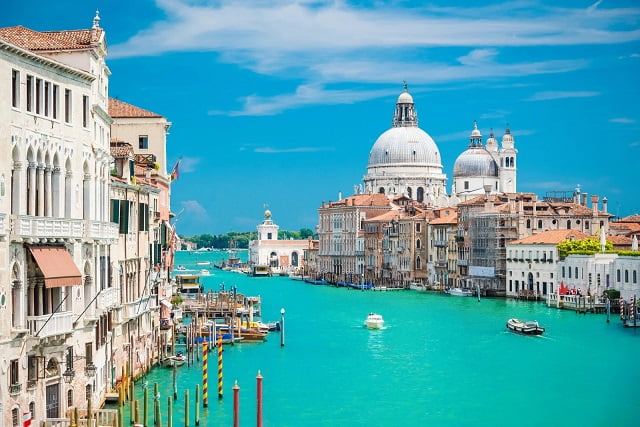With the ever-changing landscape of travel due to the COVID-19 pandemic, many Americans are wondering, “Can Americans travel to Italy?” As Italy opens its borders to tourists from around the world, including those from the United States, there are important considerations and requirements that American travelers need to be aware of before planning their trip.
From travel restrictions and vaccination requirements to quarantine measures and health and safety guidelines, navigating the current state of travel for Americans to Italy requires careful planning and preparation.
As the world continues to grapple with the effects of the global pandemic, countries like Italy have implemented travel restrictions and requirements to ensure the safety of both their citizens and visitors. For American travelers considering a trip to Italy, it’s essential to stay informed about the latest regulations and guidelines in order to have a smooth and enjoyable experience while abroad.
In this article, we will explore the current state of travel for Americans to Italy, including important information on travel restrictions and requirements, COVID-19 testing and vaccination requirements, visa and entry requirements, quarantine measures, health and safety guidelines, transportation and accommodation considerations, as well as tips for planning a trip to Italy in the current climate.
Whether you’re a seasoned traveler or looking forward to your first visit to Italy, understanding these essential aspects of traveling during a pandemic is crucial for a successful and memorable trip.
Travel Restrictions and Requirements for Americans Visiting Italy
As the COVID-19 pandemic continues to impact travel worldwide, many Americans are wondering if they can travel to Italy. The good news is that Americans can indeed travel to Italy, but there are several restrictions and requirements in place that they need to be aware of before planning their trip.
First and foremost, it is important for American travelers to understand the current travel restrictions for visiting Italy. As of now, non-essential travel from the United States to Italy is allowed, but there are certain entry requirements that must be met. This includes providing proof of a negative COVID-19 test taken within 72 hours before arrival in Italy or proof of full vaccination.
In addition to testing and vaccination requirements, it is essential for American travelers to be aware of any visa and entry requirements for their visit to Italy. While Americans do not typically need a visa for short visits to Italy, there may be specific entry requirements or documentation needed due to the ongoing pandemic.
It’s also important for American travelers to familiarize themselves with any quarantine measures that may be in place for travelers from the US to Italy. As regulations and requirements can change frequently, staying informed about quarantine measures is crucial when planning a trip to Italy.
COVID-19 Testing and Vaccination Requirements for American Travelers
The COVID-19 pandemic has significantly impacted international travel, and this includes travel to Italy for American citizens. As the situation continues to evolve, it is important for travelers to stay informed about the current requirements and restrictions in place for visiting Italy. One of the key considerations for American travelers is understanding the COVID-19 testing and vaccination requirements that are in place for entry into Italy.
COVID-19 Testing Requirements
Currently, all travelers from the United States are required to provide proof of a negative COVID-19 test result taken within 72 hours prior to their arrival in Italy. This applies to both vaccinated and unvaccinated individuals. It is important to note that only specific types of tests are accepted, such as molecular or antigenic tests. Travelers should ensure that they arrange for testing at an approved facility and obtain the necessary documentation before their trip.
Vaccination Requirements
In addition to testing, Italy also has specific requirements for vaccinated travelers from the United States. American visitors must provide proof of vaccination with a vaccine that has been approved by the European Medicines Agency (EMA) or World Health Organization (WHO). At this time, vaccines such as Pfizer, Moderna, Johnson & Johnson, AstraZeneca, and others are generally accepted. However, it is essential for travelers to verify that their particular vaccine is recognized by Italian authorities before departure.
Traveler Responsibilities
American travelers should also be aware that they may be subject to additional health screenings upon arrival in Italy, regardless of vaccination status or negative test results. It is crucial for visitors to adhere to all entry requirements and follow any health and safety guidelines provided by Italian authorities during their stay in order to ensure a smooth and safe travel experience.
As the situation remains fluid, it is advisable for American citizens planning a trip to Italy to regularly consult official sources such as the U.S. Embassy in Rome and the Italian Ministry of Foreign Affairs for updates on travel requirements. Understanding and complying with these regulations can help ensure a successful trip while mitigating the risk of travel disruptions or entry denial at the border.
Visa and Entry Requirements for American Citizens
When it comes to traveling to Italy, American citizens have certain visa and entry requirements that they must meet in order to enter the country. Here are some important considerations for American travelers:
- Entry Visa: Currently, American citizens do not need a visa for stays in Italy of up to 90 days within a 180-day period for tourism, business, or family visits. This falls under the Schengen Agreement which allows for visa-free travel within participating European countries.
- Passport Validity: It is important for American travelers to ensure that their passport is valid for at least three months beyond the intended date of departure from the Schengen area. This is a standard requirement for many European countries, including Italy.
- ETIAS Authorization: Beginning in late 2022, it is expected that Americans traveling to Italy will be required to obtain an ETIAS (European Travel Information and Authorization System) authorization before entering the Schengen Zone. The ETIAS is similar to the US ESTA (Electronic System for Travel Authorization) and will allow visitors from visa-exempt countries, such as the United States, to travel to Europe.
Travelers should always check the latest visa and entry requirements before planning their trip to Italy. The landscape of international travel can change rapidly due to various factors such as global events and health crises like COVID-19. For now, Americans can visit Italy without a visa for up to 90 days, but it’s important to stay informed about any potential changes or updates regarding entry requirements.
Quarantine Measures for Travelers From the US to Italy
As of the current state of travel for Americans to Italy, there are quarantine measures in place for travelers from the US. As the situation with COVID-19 continues to evolve, it is important for American tourists to stay informed about the latest requirements and guidelines for visiting Italy.
When traveling from the US to Italy, American citizens are required to comply with specific quarantine measures upon arrival. Upon entry into Italy, travelers from the US may be subject to a mandatory quarantine period, depending on their vaccination status and the prevailing regulations at the time of travel.
Travelers from the US can expect the following quarantine measures when visiting Italy:
- Mandatory quarantine period for unvaccinated or partially vaccinated travelers
- Exemption from quarantine for fully vaccinated travelers with proof of vaccination
- Requirements for COVID-19 testing before and after arrival
It is essential for American tourists to stay updated on any changes to these quarantine measures before planning their trip to Italy. Travelers should keep a close eye on official government resources and consult with their airline or travel agency regarding any updates or modifications to the existing requirements.
Overall, staying informed about quarantine measures is crucial for American citizens planning to travel to Italy, as compliance with these regulations will ultimately contribute to a smoother and safer experience while visiting this beautiful country.
Health and Safety Guidelines for American Tourists in Italy
When considering a trip to Italy, American travelers should be aware of the health and safety guidelines in place to protect themselves and others during their visit. As of the latest updates, the Centers for Disease Control and Prevention (CDC) advises Americans traveling to Italy to be fully vaccinated against COVID-19 before departure.
Additionally, all travelers, regardless of vaccination status, are required to provide proof of a negative COVID-19 test taken within 72 hours prior to arrival in Italy.
Upon arrival in Italy, it is important for American tourists to adhere to local health and safety measures, which can include wearing masks indoors, practicing social distancing, and following any specific guidelines outlined by the Italian government. It is also recommended that travelers carry a sufficient supply of face masks, hand sanitizer, and other personal protective equipment while exploring Italy.
For those who may have concerns about accessing healthcare while abroad, it is advisable for American tourists to familiarize themselves with the healthcare system in Italy and ensure they have appropriate travel insurance coverage that includes medical expenses related to COVID-19. By taking these precautions, Americans can enjoy their trip to Italy while prioritizing their health and safety as well as that of others around them.
| Health and Safety Guidelines | American Tourists in Italy |
|---|---|
| COVID-19 Vaccination Required | Proof of full vaccination needed for entry into Italy |
| Testing Requirements | Negative COVID-19 test within 72 hours prior to arrival necessary |
| Local Guidelines | Masks indoors, social distancing, and adherence to Italian government guidelines recommended |
Transportation and Accommodation Considerations for American Travelers
As American travelers plan their trip to Italy, there are several important considerations to keep in mind when it comes to transportation and accommodation. Navigating the transportation system in Italy can be both convenient and enjoyable, with options including trains, buses, and rental cars. When it comes to accommodation, there are numerous choices ranging from budget-friendly hostels to luxury hotels.
Transportation Options in Italy
Traveling around Italy is relatively easy thanks to its well-connected transportation system. The train network is extensive and connects major cities and smaller towns, offering a scenic way to explore the country. Buses are also a popular mode of transportation for traveling between cities or regions, providing flexibility for travelers. For those looking for more independence, renting a car can be a great option for exploring remote areas or off-the-beaten-path destinations.
Accommodation Choices
When it comes to finding a place to stay in Italy, travelers have a wide range of options available. Budget-conscious travelers can consider staying in hostels or guesthouses, which offer affordable accommodations and opportunities to meet fellow travelers. Those seeking more comfort and luxury can choose from boutique hotels, charming bed and breakfasts, or upscale resorts. Additionally, vacation rentals through platforms like Airbnb provide a unique opportunity to immerse oneself in local neighborhoods and culture.
Considerations for COVID-19
In light of the ongoing pandemic, it’s important for American travelers to consider the impact of COVID-19 on transportation and accommodation in Italy. Many transportation providers have implemented enhanced cleaning protocols and safety measures to protect passengers. Similarly, accommodations have adjusted their practices to ensure the health and safety of guests, such as increased sanitization and contactless check-in options.
As Americans plan their trip to Italy, careful consideration of transportation options and accommodation choices will help ensure a smooth and enjoyable travel experience while adhering to any COVID-19 restrictions or guidelines that may be in place.
Tips for American Travelers Planning a Trip to Italy in the Current Climate
As of the current climate, Americans can travel to Italy, but there are several important considerations to keep in mind when planning their trip. Firstly, it is crucial for American travelers to stay updated on the latest travel restrictions and requirements imposed by both the Italian government and the US Department of State.
This includes monitoring any changes in COVID-19 testing and vaccination requirements, visa and entry regulations, as well as quarantine measures for travelers from the US to Italy.
Additionally, American travelers should familiarize themselves with the health and safety guidelines implemented in Italy. This includes adhering to social distancing protocols, wearing face masks in public spaces, and practicing good hygiene habits throughout their trip. It is also recommended for tourists to frequently check local news sources and official government websites for any updates on safety guidelines and regulations.
When it comes to transportation and accommodation considerations, American travelers should plan ahead and make necessary arrangements prior to their trip. This could involve booking flights with flexible cancellation policies, choosing accommodations that prioritize cleanliness and sanitization, as well as researching transportation options within Italy such as train services or car rentals.
Overall, while navigating the ever-changing landscape of traveling to Italy as an American citizen may pose its challenges, thorough preparation and staying informed can help ensure a smooth and enjoyable trip amidst the current climate. By staying proactive and adaptable, American travelers can still experience the rich culture and beauty that Italy has to offer while prioritizing their health and safety.
| Consideration | Recommendation |
|---|---|
| Stay updated on travel restrictions | Monitor changes in COVID-19 requirements |
| Familiarize with health guidelines | Adhere to social distancing protocols |
| Transportation & Accommodation | Book flexible flights & prioritize cleanliness in accommodations |
Conclusion
In conclusion, the prospect of Americans traveling to Italy is contingent upon staying informed about the ever-changing landscape of travel restrictions and requirements. As the COVID-19 situation continues to evolve, it is essential for American citizens to closely monitor updates from official sources and consult with relevant authorities before planning their trip.
While there are currently restrictions and requirements in place for travelers from the US, it is important to stay flexible and adapt to any changes that may occur.
American travelers visiting Italy must adhere to COVID-19 testing and vaccination requirements, as well as visa and entry requirements. It is crucial for them to be aware of quarantine measures that may be in place upon arrival in Italy, as well as health and safety guidelines that they need to follow during their stay. Additionally, transportation and accommodation considerations should be carefully planned in advance to ensure a smooth travel experience.
Overall, while there are challenges and uncertainties associated with traveling to Italy as an American citizen during the current climate, with thorough research, vigilance, and preparation, it is possible for Americans to navigate these obstacles successfully. By staying informed and taking necessary precautions, American travelers can make their trip to Italy a memorable and enjoyable experience despite the challenges posed by the ongoing pandemic.
Frequently Asked Questions
Are Americans Allowed to Visit Italy?
Yes, Americans are currently allowed to visit Italy. However, there may be specific entry requirements in place due to the COVID-19 pandemic, so it’s important to check the latest travel advisories and restrictions before planning a trip.
Is It Safe to Travel to Italy Now From USA?
As of now, it is generally considered safe to travel to Italy from the USA. However, travelers should stay updated on the current situation regarding COVID-19 and follow any safety guidelines or protocols implemented by both countries.
What Documents Do I Need to Travel to Italy?
When traveling to Italy from the USA, American citizens typically need a valid passport that will remain valid for at least three months beyond their planned date of departure from the Schengen area. Depending on the purpose of your visit, you may also need a visa or other supporting documents such as proof of sufficient funds or a return ticket.
It’s advisable to check with the Italian consulate or embassy for specific requirements before traveling.

I’m a passionate traveler, writer, and Italophile. My fascination with Italy’s history, art, and culture has led me on countless adventures across the Italian landscape. Through “I Live Italy,” I share my love for this extraordinary country and aims to inspire others to explore its boundless beauty.




